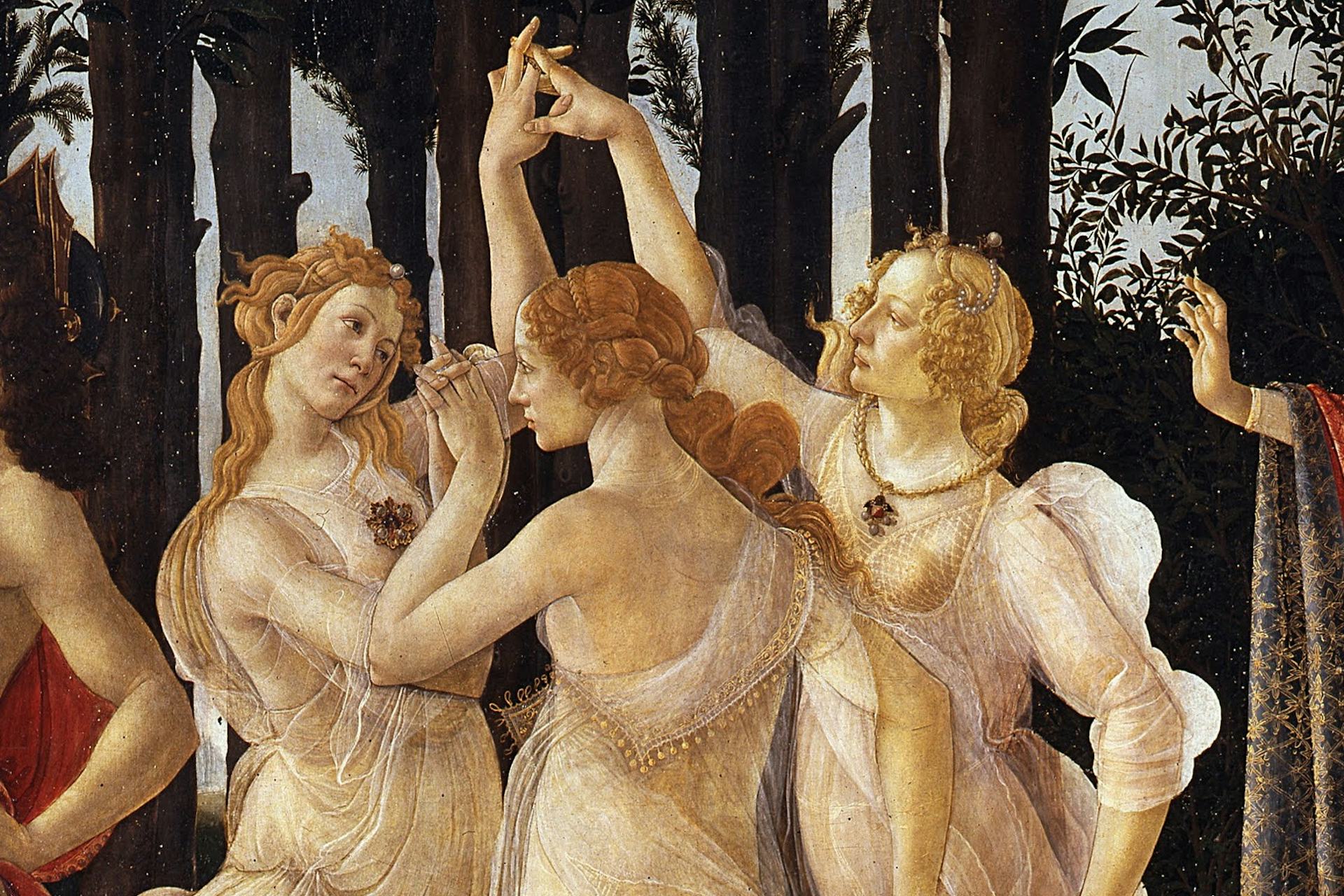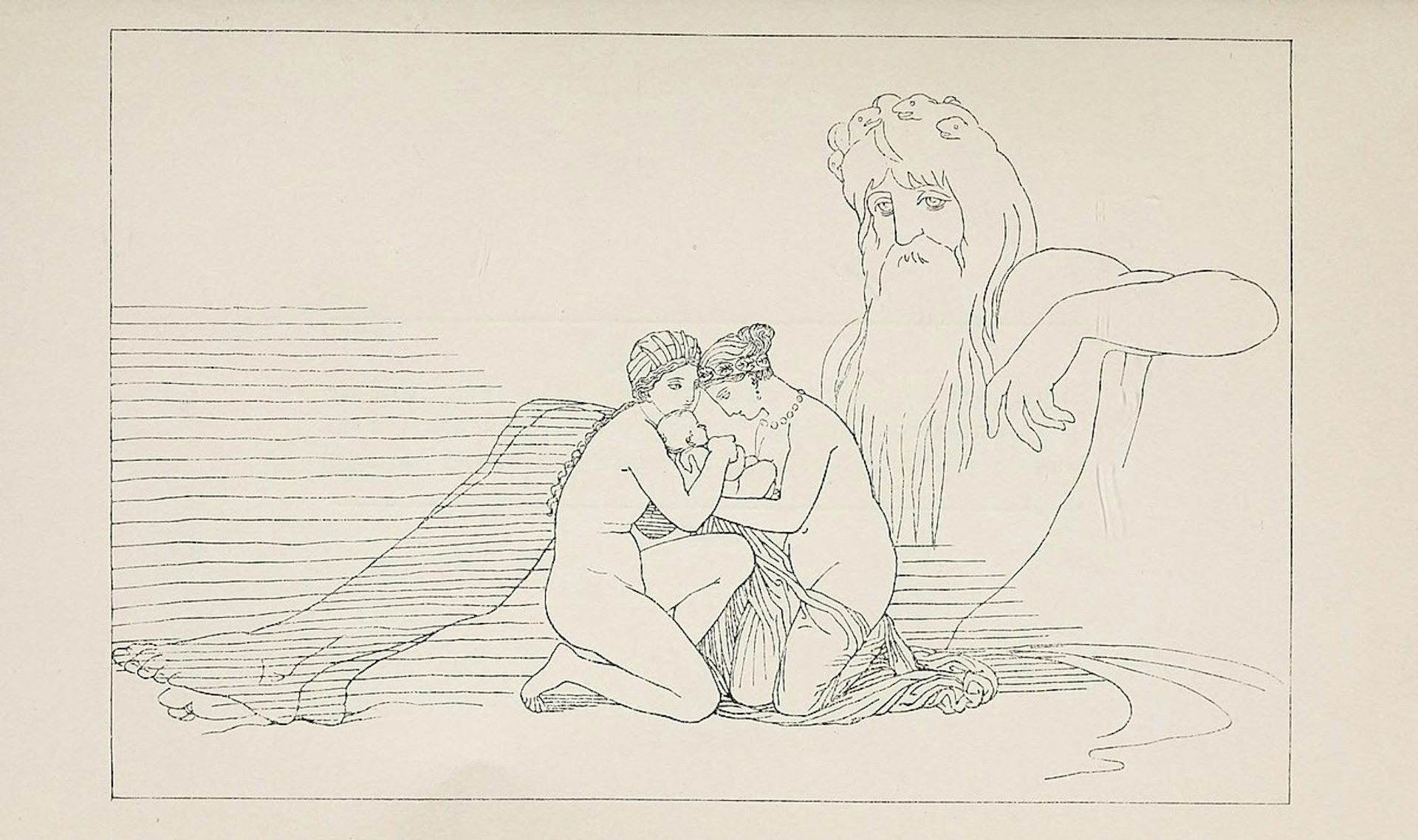Eurynome

Detail from Primavera by Sandro Botticelli (1485–1487), showing the three Graces (Charites)
Uffizi Gallery, FlorencePublic DomainOverview
Eurynome was an Oceanid, one of the three thousand nymph daughters of the Titans Oceanus and Tethys. After becoming a consort of Zeus, she gave birth to the three Charites (also known as the Graces): Aglaea (“Radiance”), Euphrosyne (“Joy”), and Thalia (“Flowering”). Some traditions claimed that she and Zeus were also the parents of the river god Asopus.
Though Eurynome was only a minor figure in Greek mythology and literature, she had a very ancient cult in the central Greek region of Arcadia. She was sometimes represented as a mermaid.

Roman Imperial statue of the three Graces (ca. 2nd century CE), restored by Nicolas Cordier in 1609
Borghese Gallery, Louvre Museum, Paris. Marie-Lan NguyenPublic DomainEtymology
The name “Eurynome” (Greek Εὐρυνόμη, translit. Eurynómē) is made up of two elements. The first is the Greek prefix εὐρυ- (eury-), meaning “broad, wide.” The second is the verb νέμω (némō), which has a range of meanings—“allot, distribute, inhabit, pasture, consume, etc.”—as well as several important derivatives, including νομή (nomḗ, “pasture”) and νόμος (nómos, “custom, law”).
Eurynome’s name can thus be translated as “widely distributing,” “widely pasturing,” “widely legislating,” and so on. In other words, it reflects Eurynome’s association with order (an association that is complemented by her role as the mother of the graceful Charites).
Pronunciation
English
Greek
Eurynome Εὐρυνόμη (Eurynómē) Phonetic
IPA
[yoo-ri-NOH-mee] /yʊ rɪˈnoʊ mi/
Titles and Epithets
As a daughter of Oceanus and Tethys, Eurynome was often called an “Oceanid” (Ὠκεανίς, Ōkeanís). One source mentions, rather obscurely, that she was also referred to as “Titanian” (Τιτηνιάς, Titēniás).[1] But Eurynome was not usually called a Titan in other sources, despite being the daughter of two Titans.
In her cult in the Arcadian town of Phigalia, Eurynome was identified with the Olympian goddess Artemis.[2]
Attributes
The Oceanids were generally imagined as generic female goddesses: beautiful, youthful, and dignified. As an Oceanid herself, this was how Eurynome was depicted in literature and art (for example, on the Pergamon Altar).
In her cult center in Phigalia, however, Eurynome was represented somewhat more distinctively: her temple contained a statue of her that had the form of “a woman as far as the hips, but below this a fish.”[3] In other words, the Eurynome worshipped by the Phigalians was a mermaid.[4]
Family
Eurynome was one of the three thousand daughters of the Titans Oceanus and Tethys, known collectively as the Oceanids.[5] Her sisters were thus the other Oceanids, while her brothers were the three thousand Potamoi (“Rivers”).
According to Hesiod, Eurynome was the third consort of Zeus, the ruler of Olympus and the most powerful of the Greek gods. Their children included the three Charites, the embodiment of all things beautiful and joyful: Aglaea (“Radiance”), Euphrosyne (“Joy”), and Thalia (“Flowering”).[6] Another tradition claimed that Eurynome and Zeus were also the parents of Asopus, the god of the River Asopus in Boeotia.[7]
But in one obscure tradition, Eurynome was instead the wife of the mysterious Ophion, with whom she ruled Olympus before the days of Cronus and Zeus.[8]
Mythology
Origins
In Greek mythology, the Titans and the Olympians were represented as fierce enemies, fighting a ten-year war known as the Titanomachy. But Eurynome belonged to a select group of Titans who were friends with the Olympians. Her parents, despite being Titans, did not fight alongside their brethren during the Titanomachy. Instead, they and their children made the wise choice of supporting Zeus.
When the Titanomachy was over, the Olympians became the new rulers of the cosmos, and the defeated Titans were cast into Tartarus. But the Titans who had helped the Olympians—including Eurynome, her parents, and her siblings—continued to thrive and received great honors under the new regime.
Mother of the Charites
After Zeus came to power, he took many lovers. He was originally married to Eurynome’s sister Metis, and then to the Titan Themis, but those marriages did not last. Eventually, Zeus made his sister Hera his wife and queen. But this did not stop the new ruler of the gods from pursuing numerous affairs with mortals and immortals alike.
One of Zeus' early divine lovers was Eurynome. In the Theogony, the poet Hesiod describes how
Eurynome, the daughter of Ocean, beautiful in form, bore [Zeus] three fair-cheeked Charites (Graces), Aglaea, and Euphrosyne, and lovely [Thalia], from whose eyes as they glanced flowed love that unnerves the limbs: and beautiful is their glance beneath their brows.[9]
Their daughters, the Charites, were goddesses who represented and personified beauty, happiness, and abundance. Hesiod knew of three Charites: Aglaea (“Radiance”), Euphrosyne (“Joy”), and Thalia (“Flowering”). But other goddesses were also referred to as Charites, including the Homeric deities Pasithea[10] and Charis.[11] The Charites lived on Mount Olympus with Himerus, the personification of desire.12
Though Hera was usually vengeful and cruel towards her husband’s illegitimate children, she does not seem to have been jealous of the Charites. In fact, Hera even allowed her son Hephaestus to marry one of them, the fair Aglaea.[13]
Eurynome and Hephaestus
In one myth, Hephaestus was cast out of Olympus by his mother Hera, who was ashamed of his deformed, crippled body. Badly hurt, he was found by Eurynome, his mother-in-law, and Thetis, one of the Nereids who eventually became the mother of Achilles. The two goddesses took Hephaestus in and nursed him back to health. Because of this kindness, Hephaestus always loved and honored both Eurynome and Thetis.[14]

Illustration showing Eurynome and Thetis nursing the young Hephaestus by John Flaxman (1910)
John Flaxman's Zeichnungen zu Sagen des Klassischen AltertumsPublic DomainAn Alternate Cosmogony: Eurynome and Ophion
In a little-known alternative to the familiar Greek cosmogony, Eurynome was originally married to a god named Ophion. It was said that they ruled the cosmos together before the reign of Cronus and Rhea:
… first of all Ophion and Eurynome, daughter of Ocean, held the sway of snowy Olympus, and how through strength of arm one yielded his prerogative to Cronos and the other to Rhea, and how they fell into the waves of Ocean; but the other two meanwhile ruled over the blessed Titan-gods, while Zeus, still a child and with the thoughts of a child, dwelt in the Dictaean cave…[15]
This strange tradition, which sharply diverges from the standard cosmogony (known from Hesiod), may reflect an earlier stage in Eurynome’s mythos in which she was a more important and central goddess in the Greek pantheon.
Worship
Though Eurynome was not widely worshipped in the ancient world, she did have an important cult in the Arcadian town of Phigalia. There, she was identified with Artemis, the Olympian goddess of hunting and the wilderness. Eurynome’s temple in Phigalia was built in a rough wooded area and contained a wooden cult image of Eurynome, which represented her as a mermaid. This statue was bound in golden chains.
A festival of Eurynome was celebrated annually at Phigalia, during which sacrifices were offered to the goddess. This was the only time of year when the temple was opened (it was kept shut for the rest of the year).[16]